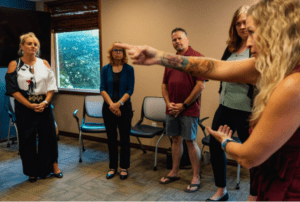TRANSFORMING KEYNOTE SPEAKING MISTAKES WITH IMPROV INSIGHTS
The world of keynote speaking is a dynamic stage where each word, gesture, and moment holds the potential to leave a lasting impact. To stand out from the crowd, speakers must navigate common mistakes with finesse. In Paul Sloane’s article on BBN Times, he shared the 8 common mistakes made by keynote speakers. In this article, we unlock the secrets to a captivating keynote speaking performance by blending the art of improv with tried-and-true public speaking principles.
1. A Weak Start
In the initial moments of your keynote, it’s crucial to captivate your audience. Unfortunately, a common mistake often occurs here. To address this, consider incorporating improv techniques to engage your audience right from the start. Skills learned from improv lessons emphasize the importance of beginning with a strong and unexpected statement. This bold approach immediately captures attention and sets an exciting tone for your presentation.
2. Overuse of PowerPoint
Effective use of slides in presentations is beneficial, especially for visual elements like charts or images. However, the mistakes of ‘death by PowerPoint’ occurs when keynote speakers overload slides with excessive text, resulting in disengagement as they read directly from the slides. Improv techniques advise a more direct connection with the audience by prioritizing relatable stories, maintaining eye contact, and letting words resonate, rather than relying solely on slides. Incorporating a personal touch fosters a meaningful connection, enhancing the overall impact of your presentation.
3. No Clear Message
Keynote speakers often make the mistake of overwhelming their audience with too much data, leading to a lack of clarity and a disjointed presentation. To avoid this, it’s crucial to focus on a central idea and structure your talk around it. Consider starting with a problem, weaving in a story, proposing a solution, and concluding with a clear call to action.
Improv encourages us to take a stance on a topic and communicate it with clarity and conviction. Distill your key message to its essence, ensuring every element of your presentation aligns with the central theme. A clear, concise message acts as a guiding beacon, leaving a lasting impression on your audience.
4. No Human Interest
In the landscape of keynote speaking, a prevalent mistake is the inclination to saturate presentations with an overflow of facts, data, and statistics, resulting in a less engaging experience. Recognizing these mistakes in keynote speaking, improv techniques provide a transformative solution.
Instead of dwelling solely on percentages and charts, improv encourages speakers to infuse humanity into their presentations by sharing compelling stories about real individuals and their experiences. By addressing these mistakes with the principles of improv, speakers can create a more authentic and captivating connection with the audience, turning what could have been a monotonous lecture into a shared and memorable experience.
5. Lack of Enthusiasm
One common mistake in keynote speaking involves a lack of enthusiasm, resulting in a disconnection with the audience. Often, speakers deliver content monotonously, reading from scripts and risking audience disengagement. This mistake of the keynote speaker in communication can be transformed by applying improv techniques.
By infusing energy and passion into the presentation, varying tone, pace, and body language, speakers can captivate their audience and transition from mere speakers to engaging storytellers on a mission. Improv serves as a powerful tool to rectify the mistake of lacking enthusiasm in keynote speaking, turning potential pitfalls into opportunities for dynamic and impactful communication.
6. Too Much Me and Not Enough You
A prevalent mistake in keynote speaking is making the talk self-centered, focusing excessively on personal achievements, company issues, and individual experiences. This mistake of the keynote speaker in communication neglects the audience’s interests and concerns. To transform this, improv emphasizes collaboration, urging speakers to tailor presentations to the audience’s needs.
By minimizing the use of ‘I’ and ‘we,’ and maximizing ‘you,’ speakers can draw out broader issues and lessons to connect to your listeners. Improv techniques transform this mistake by fostering an inclusive atmosphere through audience participation, questions, and addressing concerns, ensuring a more engaging and impactful presentation centered around the audience’s perspective.
7. No Rehearsal
Keynote speakers often make elementary mistakes on stage, struggling with equipment malfunctions, disorganized slides, and evident lack of rehearsal. This mistake of the keynote speaker in communication can be addressed by incorporating improv techniques.
Much like improv performers who rehearse through games and exercises, speakers must dedicate time to practice, refining their delivery and perfecting timing. Thorough rehearsal not only ensures seamless transitions but also instills confidence and professionalism, transforming potential pitfalls into a polished and engaging presentation.
Just as improv emphasizes preparation for spontaneous success, keynote speakers should prioritize practice to navigate the challenges of equipment issues and logistical hiccups, turning potential mistakes into confident and impactful communication.
8. Overrunning on Time
A common mistake in keynote speaking is exceeding the allotted time, a transgression that irks event organizers and audiences alike. This mistake of the keynote speaker in communication often results in rushed conclusions and the hurried inclusion of remaining slides. Improv techniques offer a transformative solution, emphasizing adaptability and effective time management.
To address this mistake, speakers should practice delivering their keynotes within a slightly shorter timeframe, ensuring a strong, confident conclusion without overrunning. This approach not only respects the audience’s time but also allows for a more impactful delivery of the key message. By mastering the art of pacing and adaptability, speakers can transform this potential pitfall into a polished presentation that leaves the audience satisfied and engaged.
Embracing the Power of Improv Insights
By embracing the wisdom of improv, keynote speakers can transform their presentations into unforgettable experiences. Now that you’re armed with the transformative insights of improv, it’s time to take your keynote speaking skills to new heights. DON’T STOP HERE!
Supercharge your growth with our exclusive coaching experience — tailored to refine your unique style and amplify your strengths.
If you are ready to create a signature message, build your platform as a speaker, and learn which stages are the RIGHT stages for you, join us in the “Yes, And” Speaker Accelerator now.
Don’t just be a speaker; become a storyteller who commands attention. Your journey to becoming a polished keynote speaker starts now. Click here to connect with us and set the stage for your remarkable transformation.
Bonus Tip: Embrace Silence for Impact
In the world of keynote speaking, the power of silence is often underestimated. Improv teaches us that silence can be a potent tool for emphasis and connection. Instead of filling every moment with words, strategically pause to let your message sink in. This deliberate use of silence not only adds gravitas to your delivery but also allows the audience to reflect on your words. Embrace the art of timing, using silence as a powerful punctuation to highlight key points and create a memorable rhythm in your presentation.




